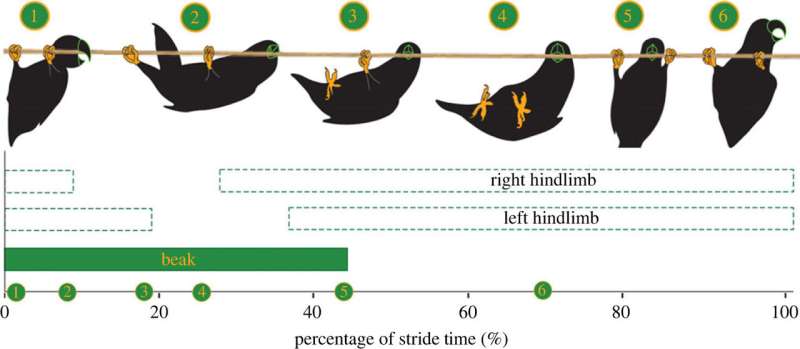January 31, 2024 report
This article has been reviewed according to Science X's editorial process and policies. Editors have highlighted the following attributes while ensuring the content's credibility:
fact-checked
peer-reviewed publication
trusted source
proofread
Parrots found to use 'beakiation' to traverse small perches

A trio of osteopathic researchers at the New York Institute of Technology College of Osteopathic Medicine has found that one species of parrot uses its beak in a novel way to traverse small perches. In their project, reported in the journal Royal Society Open Science, the group conducted experiments with rosy-faced lovebirds to learn more about how they use their heads to move around on limbs.
Prior research has shown that rosy-faced lovebirds, a type of parrot, are highly intelligent. They have been observed overcoming a wide variety of obstacles to obtain a reward, both in the wild and in captivity. They have been seen, for example, climbing up small tree branches and using their heads to propel themselves forward when in a jam.
In this new study, the research team wanted to find out if the birds used any more tricks to get around on small perches. To find out, they set up an obstacle course in their lab and filmed the birds as they moved around it.
The researchers found that the birds used one type of movement across a course that had never been observed with a bird before. After the researchers reduced the size of a fake twig to a certain size, the birds clearly found it difficult to hold on, which made moving along its length difficult. Normally, the bird would simply use its feet to sidle sideways. Finding such an approach untenable, the birds began using their beaks as a means of support.
The actions of the bird involved first stretching its head along the line of the twig toward the desired goal. Next, it grabbed the twig with its beak—hard enough to support its entire weight—and then moved first one foot forward, then the next, past the point where it was holding on with its beak.
Doing so repeatedly allowed the bird to slowly move toward the desired prize and eventually reach it. The research team has named the action "beakiation"—a nod to brachiation, which is the term used to describe how monkeys move sideways in trees.
More information: Edwin Dickinson et al, Beakiation: how a novel parrot gait expands the locomotor repertoire of living birds, Royal Society Open Science (2024). DOI: 10.1098/rsos.231397
Journal information: Royal Society Open Science
© 2024 Science X Network




















